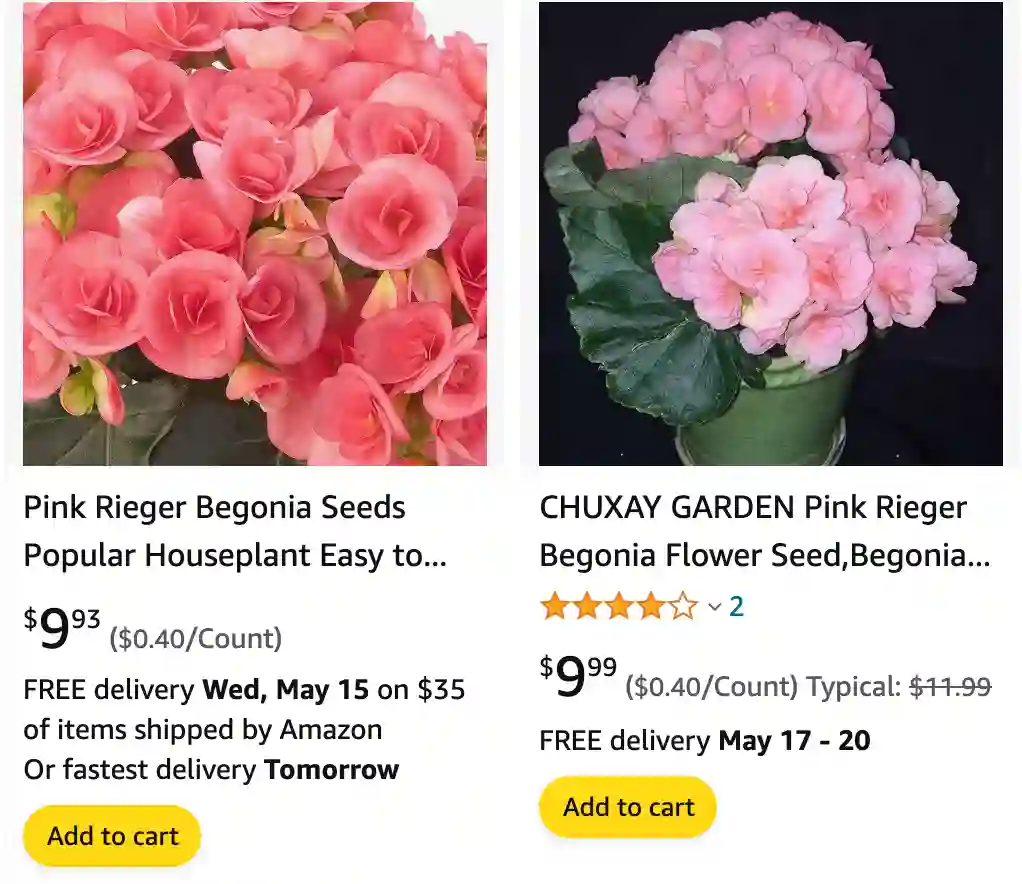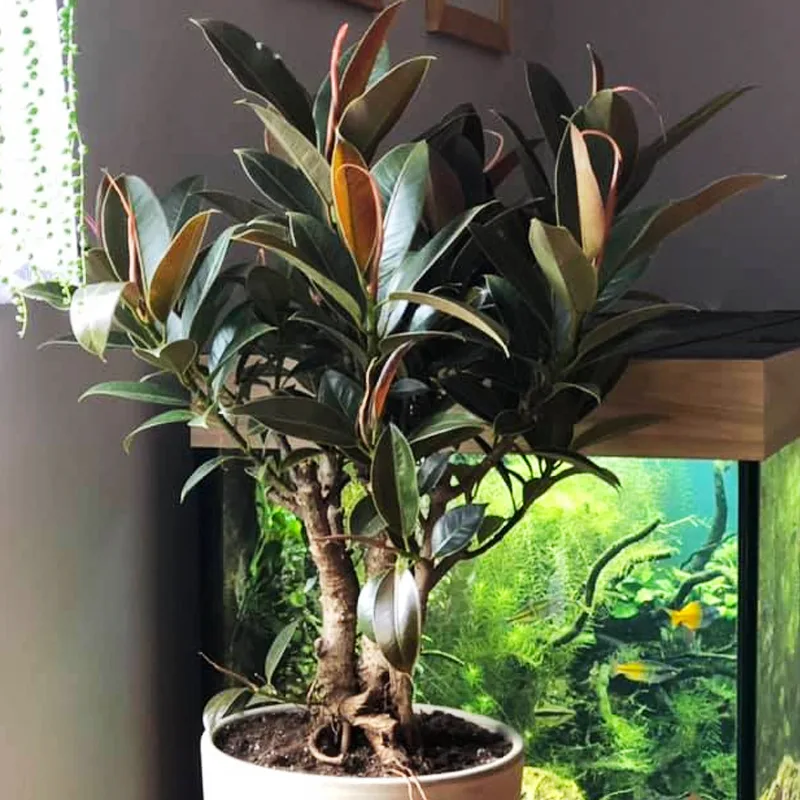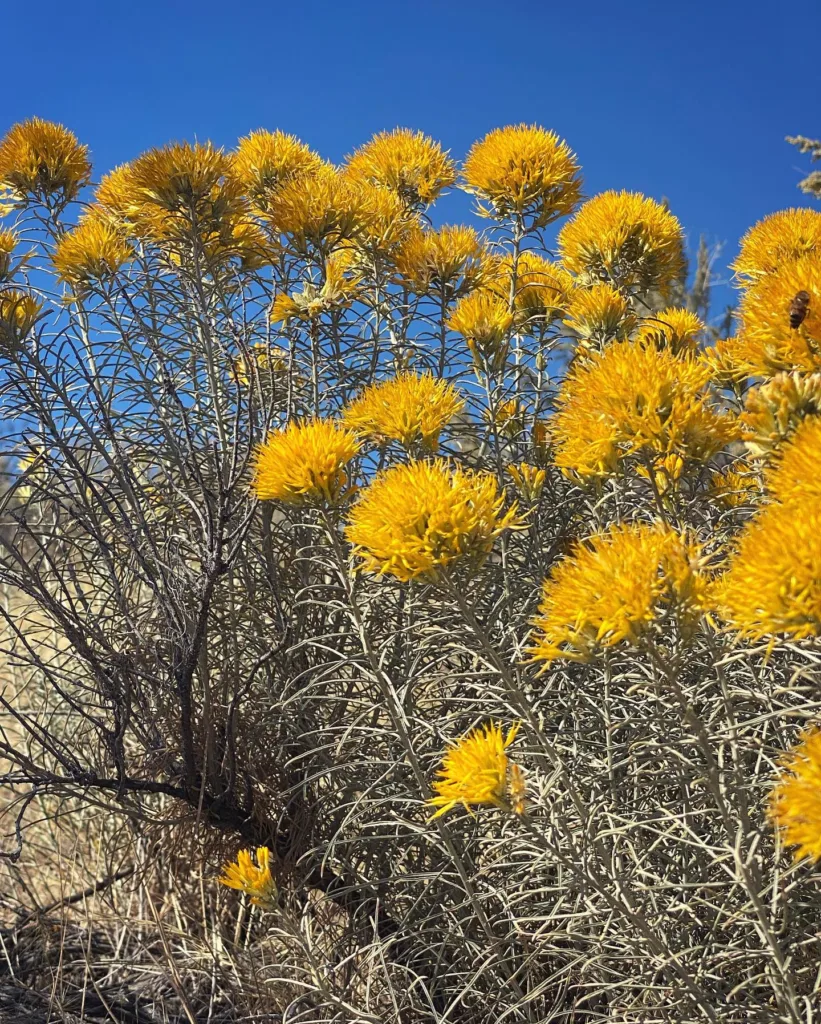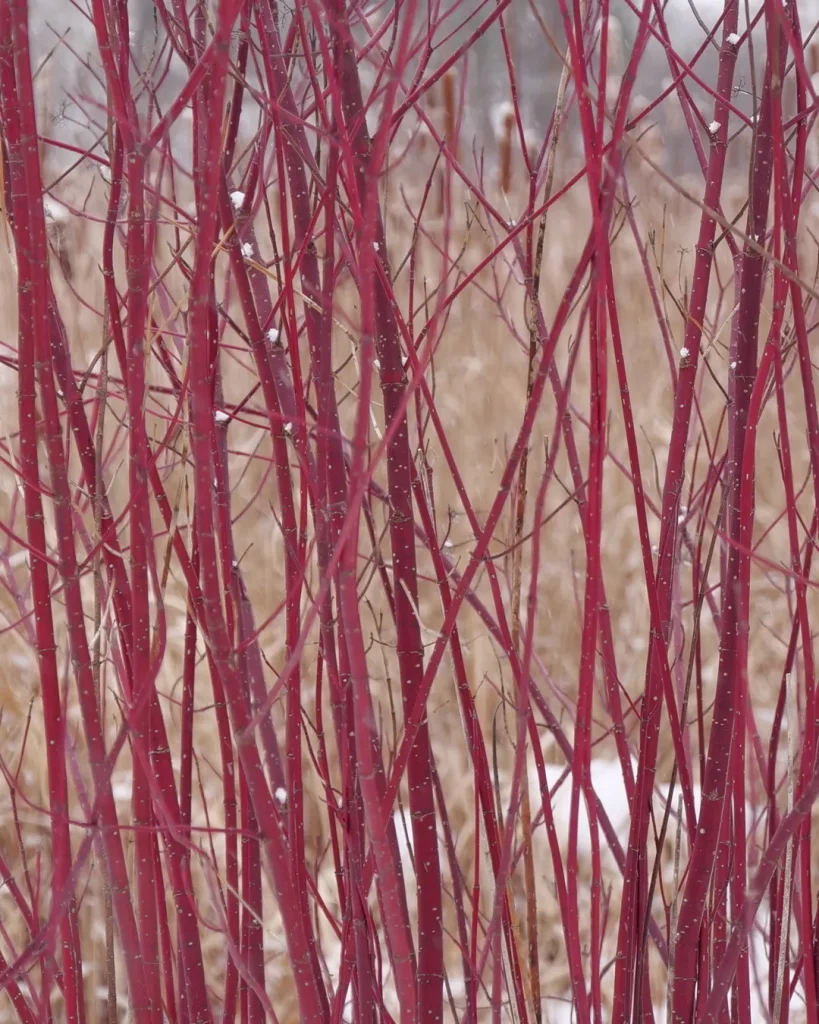
Rieger Begonias are dazzling hybrids celebrated for their abundant, rose-like blooms and compact growth habit. These popular plants are a cross between tuberous and wax begonias, combining the best traits of both to offer a spectacular floral display, especially during the cooler months. Their vibrant flowers, available in a rich palette of reds, pinks, yellows, oranges, and whites, make them a favored choice for indoor decoration and shaded outdoor containers.
Key Features of Rieger Begonias
- Showy, Rose-like Flowers: Rieger Begonias are distinguished by their densely petaled, often double or semi-double, flowers that resemble miniature roses.
- Vibrant Color Range: Blooms come in an impressive array of hues, adding a vivid splash of color to any setting.
- Compact, Bushy Growth: They typically maintain a tidy, mounded form, making them perfect for pots and containers.
- Extended Bloom Period: Unlike some other begonias, Riegers are known for their prolific and long-lasting blooming, particularly from late fall through early spring, making them ideal for brightening up indoor spaces during winter.
- Semi-Tuberous Nature: While they possess characteristics of tuberous begonias, their root structure is inconsistent, and they are often treated as temporary seasonal plants or short-lived houseplants, though they can be overwintered with proper care.
Comprehensive Care Guide for Rieger Begonias
Cultivating thriving Rieger Begonias requires attention to their specific environmental needs.
1. Light Requirements
- Bright, Indirect Light is Essential: Rieger Begonias flourish in bright, filtered light. This mimics their preferred environment where they receive ample light without direct, harsh sun exposure.
- Ideal Placement: An east or north-facing window indoors is often ideal. If placed near a south or west-facing window, use sheer curtains to diffuse the intense sunlight, as direct sun can easily scorch their leaves.
- Avoid Low Light: While they tolerate some shade, insufficient light can lead to leggy growth and reduced flower production. Artificial grow lights can supplement natural light, positioned 12−18 inches (30−45 cm) above the plant for 12−14 hours daily.
2. Watering
- Consistently Moist, Not Soggy: The key to watering Rieger Begonias is balance. They prefer their soil to be consistently moist but never waterlogged. Overwatering is a common cause of root rot.
- Check Soil Moisture: Water when the top 1 inch (2.5 cm) of soil feels dry to the touch. Stick your finger into the soil to check; if it’s moist, wait a day or two.
- Proper Drainage: Always use pots with drainage holes and ensure any excess water is emptied from the saucer after 15−20 minutes.
- Use Tepid Water: Cold water can shock the plant; use room-temperature water for best results.
- Avoid Wet Foliage: Try to water at the base of the plant to keep the leaves dry, as wet foliage can promote fungal diseases like powdery mildew.
- Seasonal Adjustments: Water more frequently during peak blooming and active growth (fall through spring). Reduce watering in the dormant summer months, allowing the soil to dry out more thoroughly between waterings.
3. Soil and Potting
- Well-Draining, Aerated Mix: Rieger Begonias thrive in a light, well-draining potting mix. A good quality mix formulated for houseplants or African violets is suitable.
- DIY Mix: You can create your own mix by combining equal parts potting soil, peat moss, and perlite or vermiculite to ensure good aeration and drainage.
- Pot Size: Choose a pot that is slightly larger than the root ball. An oversized pot can retain too much moisture, increasing the risk of root rot.
4. Temperature & Humidity
- Cool to Moderate Temperatures: Rieger Begonias prefer cooler temperatures for extended flowering, ideally between 60∘F and 75∘F (15∘C to 24∘C). To extend their bloom period, maintaining temperatures around 60−65∘F (15−18∘C) is optimal.
- Avoid Extremes: Protect them from hot and cold drafts from vents, doors, or windows. Temperatures below 50∘F (10∘C) can be detrimental.
- Appreciates Humidity: These plants benefit from moderate to high humidity levels (above 50%). To increase humidity, you can:
- Place the pot on a pebble tray filled with water (ensure the pot itself is not sitting in water).
- Use a room humidifier.
- Lightly mist the air around the plant (avoid direct misting on leaves if possible to prevent fungal issues).
5. Fertilization
- Regular Feeding During Growth: During their active growing and blooming season (typically fall through spring), fertilize every two to four weeks with a balanced, water-soluble fertilizer (e.g., NPK 15-30-15 or similar), diluted to half strength.
- Reduce in Dormancy: Scale back or cease fertilization during the summer months when the plant’s growth naturally slows. Over-fertilizing can lead to leggy growth and potential root burn.
6. Pruning and Deadheading
- Deadheading for Continuous Blooms: Regularly remove spent or faded flowers (deadhead) by gently pinching or cutting them off. This encourages the plant to produce more blooms and helps maintain a tidy appearance.
- Pinching for Bushiness: Pinch back the tips of new growth or any leggy stems to promote branching and a more compact, bushy plant shape. Also, remove any yellowing, damaged, or diseased leaves promptly.
Propagation: Extending Your Rieger Begonia’s Life
While often treated as temporary plants, Rieger Begonias can be propagated from stem cuttings.
- Take Cuttings: After the flowering period has finished, select healthy, non-flowering stems about 3 inches (7.5 cm) long.
- Harden Off: Allow the cuttings to “harden off” or air dry for about 10 days. This helps the cut end to callus, reducing the risk of rot.
- Plant: Insert the callused end into a light, well-draining potting mix.
- Environment: Provide bright, indirect light and maintain consistent moisture. High humidity can aid rooting. Once rooted, treat as a mature plant.
Popular Rieger Begonia Varieties
Breeders have developed numerous cultivars, often grouped into series, known for their abundant blooms and diverse colors. Some popular series and individual varieties include:
- Solenia Series: Known for their excellent outdoor performance, heat tolerance, and vibrant colors (e.g., ‘Solenia Apricot’, ‘Solenia Scarlet’, ‘Solenia Yellow’).
- Amstel Series: Includes varieties like ‘Amstel Blitz’ (yellow), ‘Amstel Clara’ (white), ‘Amstel Dark Britt’ (orange), and ‘Amstel Netja Dark’ (pink).
- Barkos: Features striking dark red blooms.
- Baladin: Known for its rich red, long-lasting flowers.
- Berseba: Offers soft salmon-pink blooms.
Common Pests and Diseases
Rieger Begonias are generally robust but can be susceptible to certain pests and diseases, especially if cultural conditions are not ideal.
- Pests:
- Aphids, Mealybugs, Spider Mites: These sap-sucking pests can cause distorted growth and yellowing leaves. Inspect regularly, especially the undersides of leaves. Treat with insecticidal soap or neem oil, or manually remove with a cotton swab dipped in rubbing alcohol.
- Fungus Gnats: Often a sign of consistently wet soil. Allow the soil to dry out more between waterings.
- Diseases:
- Root Rot / Stem Rot: The most common issue, caused by overwatering and poor drainage. Symptoms include yellowing leaves, wilting, and mushy stems. Ensure well-draining soil and careful watering.
- Powdery Mildew: White, powdery spots on leaves, favored by high humidity and cool temperatures with poor air circulation. Improve airflow, avoid overhead watering, and apply fungicides if needed.
- Botrytis Blight (Gray Mold): Fuzzy gray or brown spots on leaves, stems, and flowers, especially in cool, damp conditions. Remove affected plant parts and increase air circulation.
- Bacterial Leaf Spot: Can appear as water-soaked lesions or spots on leaves. Practice good hygiene (sterilize tools) and avoid splashing water on foliage.
- Fusarium: Can cause discolored leaves, stem cankers, and plant collapse. Remove and discard infected plants immediately to prevent spread.
Prevention is Key: Optimal growing conditions, good air circulation, and regular inspection are the best defense against most problems. Promptly address any issues to prevent them from spreading.
Rieger Begonias vs. Other Popular Begonias
Understanding how Rieger Begonias compare to other types can help you make informed choices for your garden or home.
- Rieger Begonias ( Begonia x hiemalis ):
- Flowers: Showy, often double, rose-like.
- Growth Habit: Compact, bushy.
- Root System: Tuberous (semi-tuberous), often treated as seasonal plants.
- Prime Season: Winter to early spring (indoors), cooler parts of spring/fall (outdoors).
- Light: Bright, indirect. Sensitive to direct sun.
- Use: Popular indoor flowering plant, also suitable for shaded outdoor containers in temperate climates.
- Begonia boliviensis (Trailing/Tuberous):
- Flowers: Elongated, bell-shaped, fuchsia-like.
- Growth Habit: Trailing/cascading.
- Root System: Tuberous, can be overwintered.
- Prime Season: Late spring through fall.
- Light: Bright, indirect. Tolerates some direct morning sun.
- Use: Ideal for hanging baskets and containers where trailing habit is desired.
- Wax Begonias ( Begonia semperflorens ):
- Flowers: Small, usually single.
- Growth Habit: Bushy, mounding.
- Root System: Fibrous.
- Prime Season: All season (as annuals).
- Light: Sun to partial shade.
- Use: Common bedding plants for mass plantings.
- Interspecific Begonias (e.g., ‘Dragon Wing’, ‘BIG’ series):
- Flowers: Larger than wax, often single.
- Growth Habit: Larger, more vigorous bushy or arching.
- Root System: Fibrous.
- Prime Season: All season.
- Light: Sun to partial shade.
- Use: Excellent for large containers and garden beds.
- Tuberous Begonias (various hybrids):
- Flowers: Very large, often double, camellia-like.
- Growth Habit: Upright or cascading.
- Root System: Tuberous.
- Prime Season: Summer.
- Light: Partial shade to morning sun. Sensitive to heat.
- Use: Dramatic showstoppers for shaded containers and hanging baskets.
Conclusion
Rieger Begonias offer an unparalleled burst of color and elegance, especially during the colder months when many other flowering plants are dormant. With their showy, rose-like blooms and compact form, they are a fantastic choice for brightening up indoor spaces or adding flair to shaded outdoor areas. By providing the right balance of light, water, and humidity, and by staying proactive against potential pests and diseases, you can enjoy the stunning beauty of these magnificent plants for an extended period. Their relatively low maintenance requirements, coupled with their dramatic floral impact, make Rieger Begonias a truly rewarding addition to any plant enthusiast’s collection.
If i die, water my plants!



